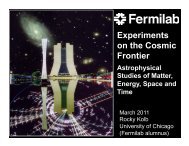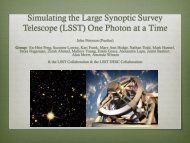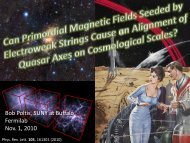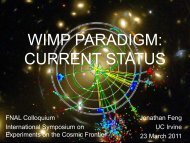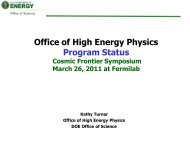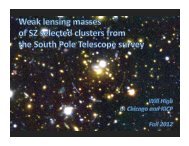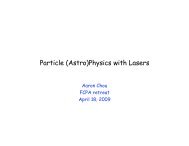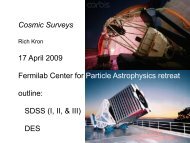Slides - Fermilab Center for Particle Astrophysics
Slides - Fermilab Center for Particle Astrophysics
Slides - Fermilab Center for Particle Astrophysics
You also want an ePaper? Increase the reach of your titles
YUMPU automatically turns print PDFs into web optimized ePapers that Google loves.
Weak and strong CP, axions,<br />
and DM<br />
Jih Jihn EE. Kim Ki<br />
Seoul National University<br />
Seattle, 29 July 2011<br />
Yale, 1 August g 2011<br />
<strong>Fermilab</strong>, 2 Aug 2011<br />
Ohio State, 4 Aug 2011
What can be there beyond SM?<br />
New CP? Axions? SUSY? String?<br />
11. Th The weak k CP violation, i l ti and d th the<br />
strong g CP conservation<br />
22. Axions<br />
3. Dark matter<br />
J E Kim Weak and Strong CP, Axions and DM USA 2011
11. The weak CP violation violation, and the<br />
strong CP conservation<br />
The P violation in weak interactions is ultimately given at low<br />
energy perspective i by b the h Gl Glashow-Salam-Weinberg h S l W i b chiral hi l<br />
model of weak interactions: the standard model.<br />
3 /75
Dark matter in the universe is the most looked-<strong>for</strong> particle(s)<br />
iin cosmology l and d at LHC LHC, and d also l at llow temperature llabs. b<br />
The 100 GeV scale DM and the10-1000 micro eV axion are<br />
the most promising candidates candidates.<br />
Neutrinos Light bosons<br />
4/75
A rough sketch of<br />
masses and d cross<br />
sections. Bosonic<br />
DM with collective<br />
motion is always<br />
CDM.<br />
J E Kim Weak and Strong CP, Axions and DM USA 2011 5 /75
The weak CP violation<br />
The charge conjugation C and parity P have been known as<br />
exact symmetries in atomic physics, i.e. in electromagnetic<br />
interactions.<br />
1924: Atomic wave functions are either<br />
symmetric y or antisymmetric: y<br />
Laporte rule<br />
1927: Nature is parity symmetric, symmetric Wigner:<br />
Laporte rule = parity symmetric<br />
6/75
Quantum mechanics was developed after the atomic rule<br />
of Laporte was known known. It is based on the<br />
SYMMETRY PRINCIPLE !!!!<br />
In QM, these symmetry operations are represented by unitary<br />
operators. For continuous symmetries, we represent them by<br />
generators<br />
U<br />
where F is a set of generators.<br />
e<br />
ii<br />
F <br />
For discrete symmetries, we use U directly like<br />
P, C, CP, etc.<br />
7 /75
CP violation observed in the neutral K-meson<br />
system (and now from B-meson system) needed to<br />
iintroduce d a CP violation i l i iin the h SM SM. IIt was given i bby the h<br />
Kobayashi-Maskawa model.<br />
8 /75
The CKM matrix has been written by y many y since the<br />
KM paper,<br />
Kobayashi-Maskawa, Prog. Theor. Phys. 49 (1973) 652<br />
using N. Cabibbo, PRL10 (1963) 531<br />
Maiani, PLB 62 (1976) 183<br />
Chau-Keung, PRL 53 (1984) 1802<br />
Wolfenstein, PRL 51 (1983) 1945 : Approximate <strong>for</strong>m<br />
Qi Qin-Ma, M PLB 695 (2011) 194 : AApproximate i t f<strong>for</strong>m<br />
RRecently, l SSeo and d I wrote an exact CKM matrix i<br />
replacing the Wolfenstein <strong>for</strong>m. Another complification in lit.?<br />
or reaching to the end of the road of writing the CKM matrix?<br />
9/75
CP violation books contain basics:<br />
GG. C. C Branco, B L. L Lavoura L and d JJ. PP. Sil Silva,<br />
CP Violation, Int. Ser. Monogr. Phys 103 (1999).<br />
II. I. I Bigi and A. A I. I Sanda, Sanda CP violation, violation Cambridge<br />
Monographs on <strong>Particle</strong> Phys. and Cosmology (2009)<br />
SStill, ill I would ld like lik to repeat the h ( (probably) b bl ) kknowns about b<br />
the CKM matrix V(CKM):<br />
11. Det Det. V(CKM) is better to be real !<br />
2. 3x3 V(CKM) is complex to describe CP violation<br />
3. If any y among g 9 elements is zero, , then there is no<br />
weak CP violation.<br />
4. λ is a good expansion parameter (Wolfenstein) .<br />
5. (31)∙(22)·(13) is the barometer of weak CP violation.<br />
6. Eventually, V(CKM) is derivable from the Yukawa<br />
texture.<br />
10 /75
1. Det. V(CKM) is better to be real !<br />
If not not, then Arg. Arg Det Det. M Mq is not zero. zero Usually, Usually we remove<br />
this to define a good quark basis. The PQ symmetry?<br />
Or calculable models?<br />
KM model has a phase. MCK do not have a phase.<br />
If it has a phase, then<br />
L L(<br />
quark - gauge int. ) L(<br />
Higgs boson)<br />
<br />
2<br />
32<br />
2<br />
gc ~<br />
GG<br />
<br />
<br />
<br />
<br />
2 ~<br />
gc GG<br />
2<br />
32<br />
The neutron EDM has the problem. Fine-tuning. So,<br />
the CKM matrix having Det=0 is a good choice.<br />
But it is not absolutely necessary necessary.<br />
11/75
4. λ is a good expansion parameter (Wolfenstein) .<br />
We expand in terms of θ 1 since θ 2 and θ 3 are of order θ 1 2 .<br />
J E Kim Weak and Strong CP, Axions and DM USA 2011 12 /75
Satisfying y g all the requirements, q , we write an exact CKM matrix, ,<br />
(31)(22)(13) is i 2<br />
2 2 2<br />
e i<br />
<br />
s<br />
1<br />
s<br />
2<br />
s<br />
3<br />
J E Kim Weak and Strong CP, Axions and DM USA 2011 13 /75<br />
c<br />
1<br />
c<br />
2<br />
c<br />
3<br />
<br />
s<br />
1<br />
s<br />
2<br />
s<br />
3
The elements of Det. V(CKM) ( ) is, ,<br />
All elements have the same imaginary part part, due to our<br />
good choice of Det. being real. But, the individual part<br />
describes CP violating processes.<br />
J E Kim Weak and Strong CP, Axions and DM USA 2011 14/75
The approximate pp <strong>for</strong>m is, ,<br />
κb, or κt , or δ being zero washes out the CP violation,<br />
in the exact or in the approximate pp <strong>for</strong>m.<br />
J E Kim Weak and Strong CP, Axions and DM USA 2011 15 /75
The Jarlskog g triangles g are<br />
These can be read directly from V(CKM).<br />
J E Kim Weak and Strong CP, Axions and DM USA 2011 16 /75
J E Kim Weak and Strong CP, Axions and DM USA 2011 17 /75
With our exact V(CKM), R=1 and R=L give<br />
Useful textures to find symmetries behind Yukawa couplings<br />
at the fundamental scale scale. BUT<br />
18 /75
In any case case, either Det V is real or there must be<br />
an axion. Both of them solves the strong CP<br />
problem.<br />
Consider, <strong>for</strong> example, there is no axion and Det<br />
V is not real real. But But, there is no dangerous NEDM<br />
diagram. Since Det V is not real, try that it has<br />
a phase 3φ<br />
Can φ appear as a physical one? Seems not not.<br />
J E Kim Weak and Strong CP, Axions and DM USA 2011 19 /75
Consider the NEDM diagram<br />
V<br />
*<br />
13<br />
V<br />
32<br />
V<br />
*<br />
21<br />
appear<br />
The<br />
overall<br />
is<br />
V *<br />
13<br />
d<br />
(11)<br />
simple<br />
s s<br />
photon<br />
V V *<br />
V 32<br />
in the<br />
element<br />
phase<br />
t u<br />
determinan<br />
does<br />
enough to<br />
makes<br />
not<br />
see<br />
t with<br />
it<br />
appear.<br />
the<br />
real,<br />
V 21<br />
V 11<br />
d<br />
m d<br />
phase<br />
so<br />
But<br />
essence.<br />
e<br />
the<br />
<br />
d<br />
3i 0<br />
.<br />
21 /75
The CP violation is an intereferance<br />
phenomenon<br />
Here the 4 couplings are related. The CKM<br />
matrix and the Jarlskog determinant encode<br />
these.<br />
What is the origin of weak CP?<br />
J E Kim Weak and Strong CP, Axions and DM USA 2011 22/75
The CP origin g is from scalar interactions<br />
1. Complex p Yukawa couplings. p g The KM idea.<br />
2. Higgs interactions. T. D. Lee and S. Weinberg<br />
In any case, we must use the mass eigenstate quarks.<br />
Then, , Case 1 gives g the CKM matrix. That’s all <strong>for</strong> KM.<br />
But Case 2 can have additional CP violating interactions<br />
through Higgs exchange exchange.<br />
J E Kim Weak and Strong CP, Axions and DM USA 2011 23 /75
The strong CP invariance<br />
The existence of instanton solution in nonabelian gauge<br />
theories needs θ vacuum [CDG, JR]. It introduces the<br />
θ term,<br />
1<br />
F F<br />
32 2<br />
2<br />
<br />
<br />
32<br />
2<br />
<br />
, <br />
QCD<br />
weak<br />
weak<br />
~<br />
FF arg.Det. M<br />
Here theta-bar is the final value taking into<br />
account the electroweak CP violation. For QCD<br />
to become a correct theory describing the CP<br />
conserving strong interaction phenomena, this<br />
CP violation must be sufficiently suppressed.<br />
J E Kim Weak and Strong CP, Axions and DM USA 2011 24 /75<br />
q
• The neutron mass term<br />
g<br />
NN<br />
i /<br />
mne<br />
m<br />
n<br />
i i<br />
/ f f<br />
The NMDM and NEDM terms<br />
The mass term and the NMDM<br />
term have the same chiral<br />
trans<strong>for</strong>mation property. So,<br />
(b)s are simultaneously removed.<br />
(a) So, d(proton)= - d(neutron).<br />
is the NEDM contribution.<br />
In our study, the VEV of pi-zero<br />
determine the size of NEDM.<br />
25 /75
It is an order of magnitude larger than<br />
Crewther et al bound bound.<br />
J E Kim Weak and Strong CP, Axions and DM USA 2011 26/75
We used C A Baker et al, PRL 97, 131801 (06), to<br />
obtain →|θ|< 0 7x10-11 obtain →|θ|< 0.7x10 11<br />
Why is this so small? : Strong CP problem.<br />
1. Calculable θ, , 2. Massless up pq quark ( (X) )<br />
3. Axion<br />
Massless up quark<br />
Suppose that we chiral-trans<strong>for</strong>m a quark,<br />
Here, θ is not physical, and there is no strong CP<br />
problem. p The p problem is, , “Is massless up pqquark<br />
phenomenologically viable?”<br />
If m=0, it is equivalent<br />
to changing g g θ → θ -2α.<br />
Thus, there exists a<br />
shift symmetry θ → θ -2α.<br />
27 /75
The famous up/down quark mass ratio from chiral pert.<br />
calculation is originally given as 5/9 [Weinberg [Weinberg,<br />
Leutwyler] which is very similar to the recent compilation,<br />
m<br />
m<br />
u 0.<br />
5,<br />
d<br />
mu m md 2.<br />
51MeV,<br />
<br />
5 5. 1 1<br />
1 1.<br />
5 MeV<br />
(Manohar-Sachrajda)<br />
Excluding the lattice<br />
cal., this is convincing g<br />
that mu=0 is not a<br />
solution now.<br />
<strong>Particle</strong> Data (2010)<br />
J E Kim “Axions and cosmological constant”SNU CTP, 8 April 2010<br />
28 /75
So, , we need to consider axions and calculable<br />
models only.<br />
For calculable models, CP violation is absent in the<br />
Lagrangian That’s the definition of calculable models.<br />
Even if CP violation occurs through scalar interactions interactions, the<br />
complex Higgs couplings do not belong to calculable<br />
models. So, , calculable models start with<br />
REAL COUPLINGS.<br />
Namely, Lagrangian conserves CP, and theta=0 is chosen<br />
as the h symmetry point. i<br />
Then Then, CP violation must be spontaneous by generating<br />
complex VEVs. And we must build models <strong>for</strong>bidding<br />
theta term up to two loop level.<br />
J E Kim Weak and Strong CP, Axions and DM USA 2011 29 /75
22. Axions
Ki Kim-Carosi, C i arXiv:0807.3125 Xi 0807 3125 “A “Axions i and dth the strong t CP problem” bl ”<br />
(Rev. Mod. Phys. 82, 511 (2010))<br />
Historically, Peccei-Quinn tried to mimick the symmetry θ → θ -2α, by<br />
the full electroweak theory. They found such a symmetry if H u is<br />
coupled to up-type quarks and H d couples to down-type quarks,<br />
d<br />
L q u H q d H V ( H , H ) <br />
L<br />
R<br />
u<br />
L<br />
R<br />
d<br />
( u d<br />
Eq. β=α<br />
achieves<br />
the same<br />
thing as the<br />
m=0 case.<br />
J E Kim Weak and Strong CP, Axions and DM USA 2011 31/75
The Lagrangian g g is invariant under changing g g θ → θ -2α.<br />
Thus, it seems that θ is not physical, since it is a phase of<br />
the PQ trans<strong>for</strong>mation. But, θ is physical. At the<br />
Lagrangian level, there seems to be no strong CP<br />
problem. But and breaks the PQ global<br />
symmetry and there results a Goldstone boson boson, axion aa<br />
[Weinberg,Wilczek]. Since θ is made field, the original<br />
cosθ dependence p becomes the ppotential<br />
of the axion a.<br />
If its potential is of the cosθ <strong>for</strong>m, always θ=a/Fa can be<br />
chosen at 0 [Instanton physics physics,PQ,Vafa PQ Vafa-Witten] Witten]. So the<br />
PQ solution of the strong CP problem is that the vacuum<br />
chooses<br />
0<br />
J E Kim Weak and Strong CP, Axions and DM USA 2011 32/75
‘tt Hooft determinental interaction and the<br />
solution of the U(1) problem. If the story<br />
ends here, the axion is exactly massless.<br />
But,….<br />
J E Kim Weak and Strong CP, Axions and DM USA 2011 33 /75
History: The Peccei-Quinn-Weinber-Wilczek axion is<br />
ruled out early in one year [Peccei, 1978]. The PQ<br />
symmetry can be incorporated by heavy quarks, using<br />
a singlet Higgs field [KSVZ axion]<br />
L<br />
Q Q S V<br />
S,<br />
H , H )<br />
L<br />
R<br />
( u d<br />
<br />
Here, Higgs doublets are neutral under PQ. If they are<br />
not neutral, neutral then it is not necessary to introduce heavy<br />
quarks [DFSZ]. In any case, the axion is the phase of<br />
the SM singlet S, S, if the VEV of SS is much above the<br />
electroweak scale.<br />
Now the couplings of S determines the axion interaction.<br />
Because it is a Goldstone boson, the couplings are of the<br />
derivative <strong>for</strong>m except the anomaly term.<br />
J E Kim Weak and Strong CP, Axions and DM USA 2011 34 /75
Namely, the parameter theta-bar is made dynamical, i.e.<br />
<br />
<br />
gc<br />
a<br />
L Fa<br />
GG,<br />
a Fa<br />
F<br />
~<br />
2<br />
1 2<br />
<br />
2<br />
2<br />
32 32<br />
F<br />
There is no potential p <strong>for</strong> the field a , but at very y low<br />
energy below the QCD chiral symmetry breaking scale,<br />
the potential consistent with the symmetry of the anomaly<br />
term is generated,<br />
V<br />
<br />
a <br />
<br />
4<br />
cos <br />
<br />
QCD 0 <br />
<br />
Fa<br />
<br />
F<br />
a<br />
35/75
In most studies, a specific example is<br />
discussed discussed. Here Here, we consider an effective<br />
theory just above the QCD scale. All heavy<br />
fields are integrated out. out<br />
Kim-Carosi, RMP82, 557 (2010)<br />
[arXiv:0807 [arXiv:0807.3125] 3125]<br />
In axion physics physics, heavy fermions carrying<br />
color charges are special. So consider the<br />
following Lagrangian<br />
J E Kim Weak and Strong CP, Axions and DM USA 2011 36/75
Heavy Q’s<br />
integrated<br />
out<br />
The axion mass depends only on the combination of<br />
(c2+c3).<br />
J E Kim Weak and Strong CP, Axions and DM USA 2011 37/75
J E Kim Weak and Strong CP, Axions and DM USA 2011 38/75
J E Kim Weak and Strong CP, Axions and DM USA 2011 39 /75
The interaction<br />
<br />
m<br />
u<br />
<br />
3<br />
<br />
<br />
0<br />
1<br />
2<br />
32<br />
2<br />
4<br />
mum d <br />
Z 2 2<br />
V [ a ] f m ( 1 cos<br />
2 <br />
( 1 Z )<br />
a<br />
F<br />
a<br />
1<br />
<br />
2<br />
<br />
F<br />
a Z f<br />
m<br />
cos ma<br />
<br />
F 11<br />
Z F<br />
a<br />
a<br />
<br />
F<br />
a<br />
F<br />
a<br />
)<br />
<br />
<br />
a<br />
F<br />
a<br />
~<br />
{ FF}<br />
7<br />
10 GeV<br />
0.<br />
6[<br />
eV ]<br />
F<br />
J E Kim Weak and Strong CP, Axions and DM USA 2011 40/75<br />
a
It is very flat if the axion decay constant is large,<br />
CP conserving point<br />
In the evolving universe universe, at some temperature temperature, say T T1, aa<br />
starts to roll down to end at the CP conserving point<br />
sufficiently closely. This analysis constrains the axion decay<br />
constant (upper bound) and the initial VEV of at T1. J E Kim Weak and Strong CP, Axions and DM USA 2011 41 /75
Bae-Huh-Kim, JCAP0809, 005<br />
m q<br />
Λ QCD<br />
J E Kim Weak and Strong CP, Axions and DM USA 2011 42/75
If we do not take into account the overshoot factor<br />
and the anharmonic correction,<br />
Inclusion of these<br />
showed the region,<br />
prev. figure<br />
J E Kim Weak and Strong CP, Axions and DM USA 2011 43/75
The relevant axion interactions are presnt presnt,<br />
Interaction<br />
em<br />
a ~ a<br />
: ca FemFem,<br />
ye<br />
ei<br />
5e<br />
a Fa<br />
8 8<br />
F<br />
F<br />
a<br />
a<br />
The Primakoff term is always present present, but the electron term<br />
is present only when the Higgs coupling to leptons carry the<br />
PQ charge.<br />
In a full theory, one must look into all the PQ charges of<br />
fermions.<br />
J E Kim Weak and Strong CP, Axions and DM USA 2011 44/75
Above the electroweak scale, we integrate out heavy<br />
fi fields. ld If colored l d quarks k are integrated i d out, iits effect ff is i<br />
appearing as the coefficient of the gluon anomaly. If only<br />
bosons are integrated out out, there is no anomaly term term.<br />
Thus, we have<br />
KSVZ: c1=0, c2=0, c3=nonzero<br />
DFSZ DFSZ: c1=0, 0 c2=nonzero, c3=00<br />
PQWW: similar to DFSZ<br />
J E Kim Weak and Strong CP, Axions and DM USA 2011 45/75
It depends on<br />
models models.<br />
There are not many<br />
calculations in<br />
string models.<br />
46 /75
White dwarf bound<br />
(1st (1 hint at the center of the axion window)<br />
st hint at the center of the axion window)<br />
J E Kim Weak and Strong CP, Axions and DM USA 2011 47/75
2.<br />
24<br />
10 <br />
13<br />
<br />
F<br />
a<br />
0.510<br />
10<br />
GeV<br />
<strong>for</strong><br />
Bae Bae, Huh Huh, JEK, JEK Kyae Kyae, Viollier Viollier, NPB 817, 817 58 (2009)<br />
N<br />
DW<br />
<br />
Isern,<br />
7 th PATRAS<br />
2011<br />
1<br />
2<br />
48 /75
ADMX Phase II & ADMX-HF Coverage<br />
van a Bibber bbe aat ASK S 2011 0<br />
V -1 g ga<br />
[GeV ]<br />
10 -12<br />
10-13 10<br />
10 -14<br />
10 -15<br />
10-16 10-16 f (GHz)<br />
이미지를 표시할 수 없습니다. 컴퓨터 메모리가 부족하여 이미지를 열 수 없거나 이미지가 손상되었습니다. 컴퓨터를 다시 시작한 후 파일을 다시 여십시오. 여전히 빨간색 x가 나타나면 이미지를 삭제한 다음 다시 삽입해야 합니다.<br />
0.5 1 2 5 10 20<br />
ADMX<br />
(complete)<br />
ADMX<br />
(Ph (Phase II)<br />
ADMX<br />
(Higher TM)<br />
ADMX - HF<br />
a ~ 023 0.23<br />
KVSZ<br />
DFSZ<br />
1 10 100<br />
m a (eV)<br />
49/75
3. Dark matter<br />
Here Here, I skip WIMPs and other Z2 odd cases cases, but<br />
simply comment on axionic DM difference from<br />
others.<br />
50 /75
B. M. Demirkoez (ATLAS), 7th B. M. Demirkoez (ATLAS), 7 PATRAS, Mykonos, 1 July 2011<br />
51/75
squark to jets jets, or<br />
gluinos to jets<br />
52 /75
q ~ q<br />
q<br />
~<br />
0<br />
1<br />
This gives the above LHC bound <strong>for</strong> the R-parity<br />
conserving CMSSM.<br />
If the R-parity conserved, also the axino or<br />
gravitino LSP models are not free from this LHC problem.<br />
For Fa=1011 GeV and 1 TeV squark mass, the vertex is<br />
shifted by a few mm order order, which is swamped by decays<br />
to NLSPs.<br />
q ~<br />
q<br />
a~<br />
, or g~<br />
3 /<br />
2<br />
53 /75
The lepton modes are not accurate enough to compete<br />
with this (MET) + jets.<br />
q <br />
l<br />
q ~ q <br />
0<br />
0<br />
1<br />
~ ~<br />
~<br />
l<br />
2,<br />
3<br />
<br />
l<br />
<br />
~<br />
54 /75
Direct detection<br />
Axion detection<br />
Colliders<br />
1. Complementarity with the<br />
assumption ti ρWIMP/ρ / a<br />
2. Identification of dark matter<br />
3. Interplay with astrophysics<br />
Indirect detection<br />
J E Kim Weak and Strong CP, Axions and DM USA 2011 55/75
EE. AAprile, il<br />
1 July 2011<br />
7th PATRAS<br />
Mykonos<br />
J E Kim Weak and Strong CP, Axions and DM USA 2011 56/75
The flat rotation curve hints the existence of DM in our<br />
galaxy galaxy.<br />
J E Kim Weak and Strong CP, Axions and DM USA 2011 57 /75
mass<br />
vel. disper. p<br />
coh. length<br />
Dark matter candidates<br />
<br />
<br />
m<br />
v<br />
<br />
m m v<br />
axion WIMP sterile<br />
10<br />
10<br />
10<br />
5<br />
17<br />
eV<br />
c<br />
cm<br />
100 GeV<br />
10<br />
10<br />
12<br />
c<br />
cm<br />
10<br />
10<br />
10<br />
keV<br />
8<br />
17 5<br />
1<br />
The axion and WIMP both behave as CDM at the time of<br />
<strong>for</strong>ming galaxies galaxies. They differ in spin and coherence lengths lengths.<br />
Sikivie and Yang pointed out that <strong>for</strong> axions there is a<br />
possibility of BEC. [PRL 103 (2009) 111301]<br />
Sikivie comments that axion is better in explaining the<br />
inner caustics and angluar momentum of galaxies.<br />
J E Kim Weak and Strong CP, Axions and DM USA 2011 58 /75<br />
c<br />
cm
Tidal torque theory with axion BEC<br />
Not irrotational:<br />
net overall rotation<br />
Sikivie: Talkat7th Sikivie: Talk at 7 PATRAS 2011<br />
th PATRAS, 2011<br />
By BEC<br />
By BEC<br />
Net overall rotation is obtained because, in the lowest energy state,<br />
all axions fall with the same angular g momentum. Two distinctive behaviors<br />
be<strong>for</strong>e the dark matter falls into galactic halos. WIMPs have an irrotational<br />
velocity field whereas axions fall in with net overall rotation. Axions do this<br />
because they go to the lowest energy state <strong>for</strong> given angular momentum<br />
BEFORE FORMING GALAXIES. That state has net overall rotation.<br />
J E Kim Weak and Strong CP, Axions and DM USA 2011 59/75
Why BEC ? by yielding their energy to the non-condensed<br />
particles, the total entropy is increased.<br />
Pre BEC BEC<br />
<br />
To same p and same E<br />
J E Kim Weak and Strong CP, Axions and DM USA 2011 60/75
neighboring<br />
protogalaxy l<br />
<br />
v 0<br />
Tidal torque theory<br />
with ordinary CDM<br />
the velocity field remains irrotational<br />
J E Kim Weak and Strong CP, Axions and DM USA 2011 61 /75
Sikivie: the caustics are different in the two cases:<br />
Caustic rings <strong>for</strong> axions and `tent-like' caustics <strong>for</strong> WIMPs.<br />
Th The evidence id my collaborators ll b t and d I ffound d f<strong>for</strong> caustic ti<br />
rings is only consistent with axions.<br />
So the bulk of dark matter must be axions.<br />
J E Kim Weak and Strong CP, Axions and DM USA 2011 62 /75
ATLAS on SUSY<br />
SUSY confronts data<br />
CMS on Z’ Z<br />
The squark and gluinos are excluded roughly below 1 TeV TeV,<br />
and extra Z’ below 1.6 TeV (1.9 TeV without SUSY).<br />
Regarding this I comment my recent works.<br />
J E Kim Weak and Strong CP, Axions and DM USA 2011 63 /75
GUT gauge g g ggroup p : SU(6) ( ) GUT<br />
Flavor unification: JEK JEK, PLB107 (1982) 69<br />
This GUT contains the previous SU(3) WW. So So, if we succed<br />
in unification with SU(3) c, then the needed flavor symmetry<br />
will result. In F-theory, we succeeded.<br />
J E Kim Weak and Strong CP, Axions and DM USA 2011 64/75
For diagonal subgroups of E6, any U(1) generator can be<br />
a li linear combination bi i of f CCartan subgroup b of f E E6. SSo,<br />
we<br />
prove in terms of the Cartan subgroup of SU(6)xSU(2).<br />
F 3, F 8, T 3, Y, Y 6, X 3<br />
Leptons p and Higgs gg doublets do not carry y the baryon y<br />
number.<br />
B aY bY<br />
cX<br />
<br />
6 3<br />
dR<br />
No solution.<br />
JEK+S. Shin,<br />
1104 1104.5500 5500<br />
J E Kim Weak and Strong CP, Axions and DM USA 2011 65/75
For leptophobic Z’, we may try<br />
1 5<br />
1<br />
1<br />
1<br />
<br />
Y'<br />
Y6<br />
Y , , , 0,<br />
0,<br />
1<br />
3 6 6<br />
3 3 3 <br />
Hu carries a nonvanishing Y’. So, N has a novanishing Y’<br />
and singlet neutrino mass scale is the Z’ Z mass scale. scale<br />
So, we consider Z’ coupling both to B and L.<br />
For Z6 hexality, we consider SU(6)xSU(2).<br />
J E Kim Weak and Strong CP, Axions and DM USA 2011 66/75
Still, we studied the Z-Z’ mass in the SU(6)xSU(2) model<br />
with fine tuned coupling constants constants.<br />
So, we consider SU(6)xSU(2)<br />
In this study, y we assume of<br />
course the lepton coupling<br />
to Z’. Then, the LEP2<br />
precision ii experiment i t<br />
bound on the rho<br />
parameter is crucial to<br />
constrain the model.<br />
J E Kim Weak and Strong CP, Axions and DM USA 2011 67 /75
Effective SUSY<br />
CCohen-Kaplan-Nelson, h K l N l PLB 388 388, 588 (1996)<br />
The first two family sfermions are heavy, but the third family<br />
sfermions are at TeV TeV.<br />
To obtain this kind, we assign different quantum<br />
numbers to the third family members. The mediation<br />
mechanism is Z’ meditation. Langacker et al., PRL 100, 041802 (2008);<br />
Mohapatra+Nandi, PRL 79, 181 (1997)<br />
It is different from the<br />
E6 GUT.<br />
Jeong+JEK+Seo,<br />
1107 1107.5613 5613<br />
J E Kim Weak and Strong CP, Axions and DM USA 2011 68 /75
Z’ mediation to effSUSY<br />
J E Kim Weak and Strong CP, Axions and DM USA 2011 69/75
J E Kim Weak and Strong CP, Axions and DM USA 2011 70 /75
Three quark families appear as<br />
3(3 3 (3c, 3 3W) )<br />
At low energy, we must<br />
hhave nine i 3* W tto cancel l SU(3) W<br />
anomaly.<br />
d u X +<br />
d u X +<br />
3Hu + 3 lep+3 H 1d N 0<br />
3 3 6<br />
Both H Hu and H d appear from 3* 3 .<br />
It is in contrast to the other<br />
cases such as in SU(5) or SO(10).<br />
Now, the Hu and Hd coupling must<br />
come from 3* W 3* W 3* W coupling.<br />
D H 0 H + e- ν<br />
(H- ) (H0 )<br />
There remain three pairs of 3* W(H + ) and 3* W(H- ) plus<br />
three families of 3W(quark) and 3* W(lepton)<br />
J E Kim Weak and Strong CP, Axions and DM USA 2011 71 /75
Th Thus, there th appears the th LLevi-Civita i Ci it symbol b l and d ttwo epsilons il are<br />
appearing, in SU(3) W space, a, b, c and in flavor space, I, J, ….<br />
There<strong>for</strong>e, in the flavor space the Hu-Hd mass matrix is antisymmetric and<br />
hence its determinant is zero.<br />
Introduction of flavor in the Higgs sector:<br />
Lee-Weinberg g SU(3)-weak ( ) gives g<br />
3*-3*-3* SU(3)-weak singlet = antisymmetric gives<br />
antisymmetric bosonic flavor symmetry (SUSY)!<br />
and d one pair i of f Hi Higgs ddoublets bl t iis massless. l<br />
J E Kim Weak and Strong CP, Axions and DM USA 2011 72 /75
The hierarchy of SUSY partner masses are<br />
M a<br />
M<br />
~<br />
Z '<br />
g g<br />
( )<br />
<br />
( 16<br />
)<br />
2<br />
gY<br />
' '2<br />
F<br />
Y 2<br />
16 16 M<br />
2 2<br />
Y ' a M 2 2 Z 'log<br />
mess<br />
mess<br />
<br />
<br />
M<br />
Z '<br />
<br />
<br />
<br />
M<br />
g<br />
Y<br />
'<br />
Y '<br />
~<br />
q~<br />
, l <br />
~ ~ ( )<br />
M<br />
,<br />
'<br />
log<br />
<br />
q Z <br />
1,<br />
2 l1,<br />
2<br />
M Z '<br />
4<br />
<br />
<br />
<br />
<br />
J E Kim Weak and Strong CP, Axions and DM USA 2011 73 /75<br />
3/2
1. In fact, this kind of model is already present in<br />
string compactification compactification. [JEK [JEK, plb 656 656, 207 (2007)<br />
[arXiv:0707.3292]]<br />
2. One Higgs doublet pair.<br />
3. Quantum numbers of extra U(1)’ charges as needed<br />
in the U(1)’ mediation.<br />
J E Kim Weak and Strong CP, Axions and DM USA 2011 74/75
Conclusion<br />
Here, I talked a few topics beyond the SM paying attention<br />
to my recent papers.<br />
1. A useful suggestion <strong>for</strong> the CKM matrix.<br />
2. Weak CP and strong CP, and axions.<br />
3. There is no Z’ below 10 TeV from E6, otherwise our<br />
wisdom to the standard model is in trouble trouble.<br />
4. U(1) U(1)’ mediation possible consistent with the recent LHC<br />
data. For example, in flavor unification models, not<br />
in E6 GUT.<br />
J E Kim Weak and Strong CP, Axions and DM USA 2011 75 /75



